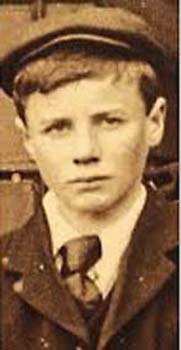A little while ago I introduced you to a young gentleman and Old Nottinghamian, called Dennis Everard Rhodes. He had written a poem in the School Magazine entitled “CAT (After D.H. Lawrence)” It was published in the Nottinghamian in July 1941, when Dennis was just eighteen. Here’s the High School at the time:

Amazingly, Dennis died only 18 months or so ago. He seems to have been one of the cleverest people who ever came to our school. A man of astounding brilliance and scholarship. I’m hoping in about 700 words to show you by how much he is cleverer than even a relatively clever person.
Firstly, let me quote you some of his obituary by Dr Lotte Hellinga which is expected to appear in The Library magazine in 2021:
“Dennis Everard Rhodes, Gold Medallist of the Bibliographical Society in 2007 and staunch contributor to The Library from 1952, died on April 7th 2020, aged 97…….
His studies began in 1941 with classical Greek, but he soon switched to Italian language and literature. During the war, he was already fluent enough in Italian to join the Intelligence Corps as interpreter during the Italian Campaign. He not only perfected his use of the language, but it discovered a country, its culture and its people that he came to love and where he felt at home. Italy in all its great cultural variety remained one of the two poles between which he conducted his life, the other being the British Museum, not less so when it was transformed into the British Library.
In 1950 he became Assistant Keeper in the Department of Printed Books at the British Museum Library. His mentors were both deeply immersed in the cataloguing and investigation of early printed books, and Dennis followed them in the same direction. He thrived in the Italian section, but his particular interest was in incunabula.
Dennis’ commitment to the library lasted his entire lifetime, through its separation from the Museum and becoming the British Library in 1973, then his appointment as Head of Incunabula in 1974, his promotion to Deputy Keeper in 1978, his retirement in 1985, and the move to the new building in 1998; almost to the very end of his life he simply stayed on, most of those years continuing with work behind the scenes.”
An “incunabulum”, by the way, is “an early printed book, especially one printed before 1501.” “incunabula” is the plural. Surely you have not forgotten that old aide-mémoire:
“Please remember every day.
Neuter plurals end in “A”.”
Dennis’ obituary will reveal in much greater depth the all encompassing intellectual life of Dr Dennis Rhodes. You can read it here.
Dennis wrote a lot of very specialised books. You can fine a list of his book titles here. Here is one of the pages for you to look at if you follow the link. Just look how wide ranging these titles are:

This bookseller and dealer in fine art is selling an archive of some of Dennis’ work. He could almost sell it by weight! This picture below is only a tiny fraction of Dennis’ work :

Dennis’ books are held by most universities in the Western World. He did not always write in English. Here is the list of which of Dennis’ books are held just in the various libraries at the University of Gent in Belgium. Just click on “Search collection”.

Dennis’ publications are, of course, to be found in most of the universities of the world. Let’s look at the website.
First of all, there is an overview of who Dennis was, what type of things he wrote, and, most impressive, how many of his works are held by libraries worldwide. And the answer? Well in excess of six thousand, scattered across the globe.

The same webpage begins that list of the more than five hundred of Dennis’ works, which are held by so many libraries.

With the last entry on the previous webpage, incidentally, we can see just how interested Dennis became in the spread of printing across Asia. What is even more impressive, of course, is that every single one of these first nine books on the list are held by a minimum of two hundred libraries world wide.
Dennis created an amazing volume of material in his lifetime and modern websites talk about Dennis’s prodigious productivity. As well as his books, in sixty-seven years he wrote over 450 such articles as well as about one hundred book reviews.
The first thing I did when I came across the name “Dennis Everard Rhodes”, was to google it. I was amazed to find that in the first five pages, some fifty or so URL addresses, only a very few were not our DE Rhodes. In more than ten years researching Old Nottinghamians, I have never ever had a result like that. Just take the trouble to pause the gallery and to have a look at the titles (in blue). Surely these entries cover about as wide a spectrum as they possibly could :
Only on the fifth page are there any interlopers., with the Norfolk Record Office and the Jamaican Family Search.
And finally, the only picture of the Great Man I have been able to find.

I have borrowed the photograph from a page of PRPH Books.















































